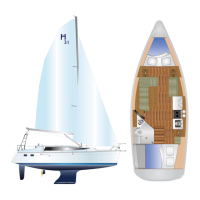GLOSSARY OF SAILING TERMS
PAGE
(rate UK); 3, UK: the distance a boat
is carried by a current in a given time.
Drogue: a sea anchor put over the
stern of a boat or life raft to retard drift.
Drop keel: a retractable keel which
can be drawn into the hull, when en-
tering shallow waters and recovering
on to a trailer.
E
Eye of the wind: direction from which
the true wind blows.
F
Fair: well-faired line or surface is
smoother with no bumps, hollows or
abrupt changes in directions.
Fairlead: a fitting through which a line
is run to alter the lead of the line.
Fathom: the measurement used for
depths of water and lengths or rope. 1
fathom = 6 ft. or 1.83m.
Fid: a tapered tool used for splicing
heavy rope and for sail-making, often
hollow.
Fiddle: a raised border for a cabin ta-
ble, chart table etc., to prevent objects
falling off when the boat heels.
Fix: the position of the vessel as plot-
ted from two or more position lines.
Forestay: the foremost stay, running
from the masthead to the stemhead,
to which the headsail is hanked.
Freeboard: vertical distance between
the waterline and the top of the deck.
G
Genoa: a large headsail, in various
sizes, which overlaps the mainsail and
is hoisted in light to fresh winds on all
points of sailing.
Gimbals: two concentric rings, piv-
oted at right angles, which keeps ob-
jects horizontal despite the boat’s mo-
tion, e. g. compass and cooker.
Go about: to turn the boat through the
eye of the wind to change tack.
Gooseneck: the fitting attaching the
boom to the mast, allowing it to move
in all directions.
Goosewing: to boom-out the headsail
to windward on a run by using a
whisker pole to hold the sail on the
opposite side to the mainsail.
Ground tackle: general term used for
anchoring gear.
Guard rail: a metal rail fitted around
the boat to prevent the crew falling
overboard.
Gudgeon: a rudder fitting. It is the eye
into which the pintle fits.
Guy: a steadying rope for a spar; a
spinnaker guy controls the fore and aft
position of the spinnaker pole; the
foreguy holds the spinnaker pole for-
ward and down.
Gybe: to change from one tack to an-
other by turning the stern through the
wind.
H
Halyard: rope used to hoist and lower
sails.
Hank: fitting used to attach the luff of
a sail to a stay.
Hatch: an opening in the deck giving
access to the interior.
Hawes pipe: see Navel pipe.
Head-topwind: when the bows are
pointing right into the wind.
Headfoil: a streamlined surround to a
forestay, with a groove into which a
headsail luff slides.
Heads: the toilet.
Headway: the forward movement of a
boat through the water.
Heave-to: to back the jib and lash the
tiller to leeward; used in heavy
weather to encourage the boat to lie
quietly and to reduce headway.
Heaving line: a light line suitable for
throwing ashore.
Heel: to lean over to one side.
I
Isobars: lines on a weather map join-
ing places of equal atmospheric pres-
sure.
J
Jackstay: a line running fore and aft,
on both sides of the boat, to which
safety harnesses are clipped.
Jury: a temporary device to replace
lost or damaged gear.
K
Keel: the main backbone of the boat
to which a ballast keel is bolted or
through which the centerboard
passes.
Kicking strap: a line used to pull the
boom down, to keep it horizontal, par-
ticularly on a reach or run.
L
Lanyard: a short line attached to one
object, such as a knife, with which it is
secured to another.
Leech: 1, the after edge of a triangle
sail; 2, both side edges of a square
sail.
Leehelm: the tendency of a boat to
bear away from the wind.
Lee shore: a shore on to which the
wind blows.
Leeward: away from the wind; the di-
rection to which the wind blows.
Leeway: the sideways movement of a
boat off its course as a result of the
wind blowing on one side of the sails.
Lifeline: a wire or rope rigged around
the deck to prevent the crew falling
overboard.
Limber holes: gaps left at the lower
end of frames above the keel to allow
water to drain to the lowest point of
the bilges.
List: a boat’s more or less permanent
lean to one side, owing to the im-
proper distribution of weight, e.g., bal-
last or water.
Log: 1, an instrument for measuring a
boat’s speed and distance traveled
through the water; 2, to record in a
book the details of a voyage, usually
distances covered and weather.
Luff: the forward edge of a sail. To luff
up is to turn a boat’s head right into
the wind.
Luff groove: a groove in a wooden or
metal spar into which the luff of a
headsail is fed.
Lurch: the sudden roll of a boat.
M
Marlin spike: a pointed steel or
wooden spike used to open up the
strands of rope or wire then splicing.
Mast Step: the socket in which the
base of the mast is located.
Measured mile: a distance of one
nautical mile measured between
buoys or transits/ranges ashore, and
marked on the chart.

